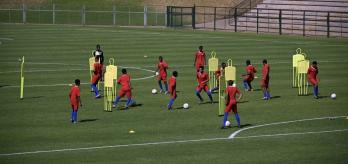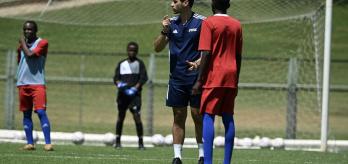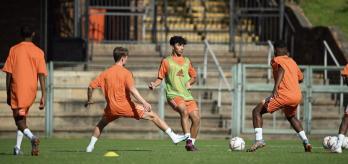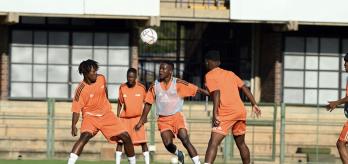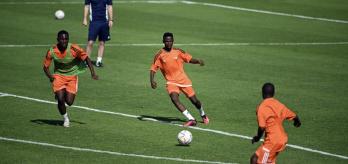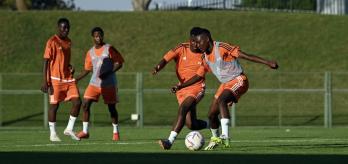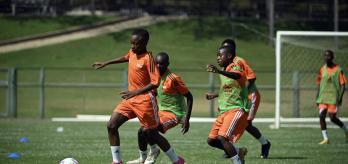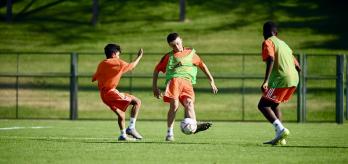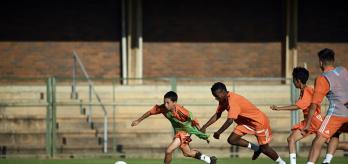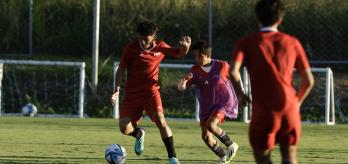Methodology
The intention: What is practised?
The aim of this exercise is to improve a player's ability to build and progress play, with a particular focus on their technical execution when receiving the ball between opponents. The goal is for the player to turn away from opponents and aim for a strategic forward pass. Players are required to demonstrate awareness by frequently scanning the field, navigating obstacles, and finding ways to move the game forward. Players are also encouraged to adopt an open body shape that enables them to see at least three corners of the exercise area, while they are asked to receive the ball on their back foot, which allows them to turn out towards the open space. The practice simulates a build-up or ball progression phase in which a player drops or drifts into the space between two opposing defenders and receives the ball with a view to playing forward.
The scale: For whom is this relevant?
The drill revolves around the player, with a particular focus on spatial awareness when receiving the ball between defenders and turning to play forward. The exercise allows players to develop their skills when receiving between opposing players and is particularly relevant to players who operate inside the opposition’s shape in central areas, such as midfielders, attacking midfielders and inverted wingers, who are tasked with identifying the most appropriate space between the opposition to drop or drift into to allow them to receive, turn and progress play while overcoming one of the opposition’s defensive lines. The players positioned on the outside of the exercise area, who play passes into the players located inside the exercise area, represent players who build the play outside of the opposition’s shape, such as centre-backs and goalkeepers, while the receiving players on the inside can be considered as target players, such as centre-forwards or attackers, who wait in front of the opposition’s defensive lines.
The practice type: How is the practice designed?
The exercise involves an unopposed passing activation, featuring variable scenarios that provide players with ample opportunities to practise receiving and turning between opposing players. The outfield players give direction to the exercise, with the players positioned inside the exercise area asked to identify a pass to receive, while the players situated on the outside provide a target to pass into. Mannequins are used to simulate opposing defenders and provide the players on the inside of the exercise area with a reference as to where a defender’s blind side may be, enabling them to position themselves accordingly. Despite the exercise being unopposed, players are still required to navigate their way through areas in which there is limited space and to avoid other players’ movements and the mannequins to make effective decisions when picking out a forward pass. The exercise is non-position-specific, with all players performing the action anywhere inside the opposition’s shape and no specific roles assigned.
Session plan
Organisation
-
Mark out a 25x25m exercise area.
-
Place 10 mannequins inside the exercise area at varying distances from each other.
-
Divide the group into 2. Position the players in 1 group at equal distances from each other around the outside of the exercise area and place the players in the other group inside the exercise area.
- Give each of the players on the outside of the exercise area a ball.
Explanation
-
The exercise begins with each of the players positioned on the outside of the exercise area playing a pass towards a player inside the exercise area.
-
The players inside the exercise area must show for the ball and receive the pass between any of the mannequins.
-
Once they receive the ball, they must turn out and identify a free player positioned on the outside of the exercise area to pass to.
-
After completing this sequence, the players on the inside of the exercise area look to receive another pass from a player on the outside of the exercise area.
-
Rotate the 2 groups so that all players have the opportunity to perform both roles.
Key coaching points
Roles of coaches
-
First coach: leads the exercise and explains key aspects relating to receiving and playing forward between opposition players.
-
Second coach: offers the players encouragement from their position on the outside of one sides of the exercise area.
-
Third coach: offers the players encouragement from their position on the outside of the opposite side of the exercise area to the second coach.




























